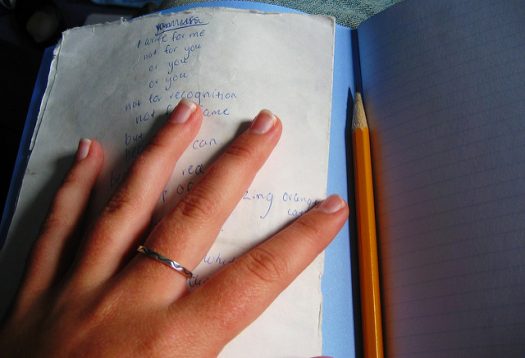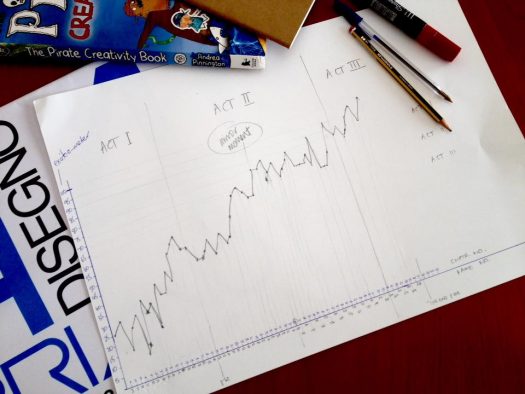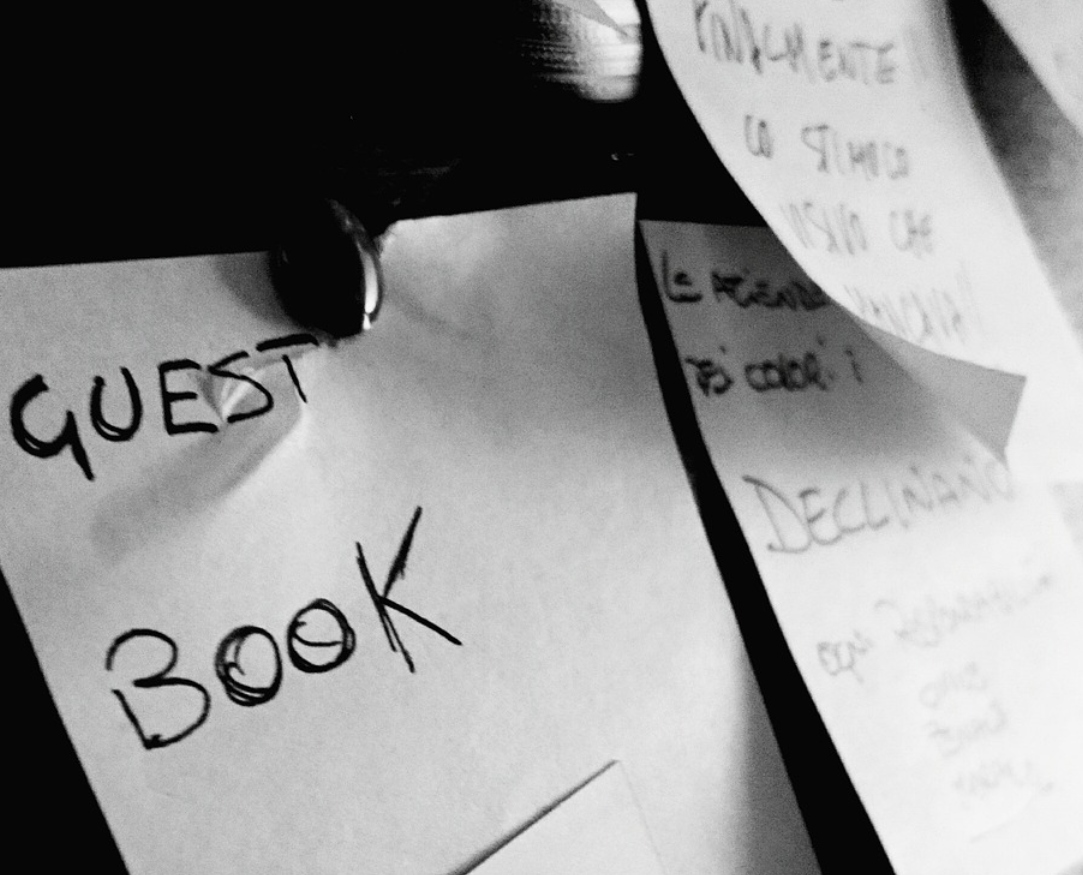Me and My Excite-O-Meter: Having Fun With Structural Revision
By Guest | August 17, 2016 |

Words Flow by katie wheeler, Flickr CC
Please welcome back guest Gaëtane Burkolter: born in Africa, she spent her early childhood in Switzerland, grew up in Australia and recently completed a four year stint in Italy. Gaëtane has a Bachelor of Arts (Communications) from the University of Technology, Sydney, and almost twenty years of experience in government communications and public relations. Becoming a parent relatively late in life opened the floodgates to long-suppressed creativity, and she is now a multi-passionate artist pursuing writing, photography, and painting. As an introvert and low-techer, she is undecided about whether she has what it takes to make it in the rough and tumble of the publishing world, but has “sneakily completed” the first draft of a sci-fi novel anyway.
Read more of Gaëtane’s musings on how to manage anxiety and other messy feelings for creative types on FaceBook, with her group First Aid for Writers, catch her on Instagram @cajetanedesign, and connect with her through comments to this post—but please note she will be responding from her home in Australia, and because of the time difference from the U.S., there may be a delay in her replies.
Me and My Excite-O-Meter: Having Fun With Structural Revision
I hit a rough patch a few weeks back, heading into deep revision of my first fiction manuscript. I didn’t know where to start. Overwhelm set in and then I panicked. What do I know about fixing up a dirty first draft? Where am I going to get the energy to trawl through that sucker? How could I possibly drag myself up off the floor to face my mistakes after the triumph of crashing through to ‘The End’?
And the most horrible, awful thing of all? The reams of advice out there. So many guidelines, so many excellent insights, so many guaranteed formulas for success. Terrifying.
I knew I needed to assess the overall structure of my novel. I also knew there was a veritable canon of texts I could draw on.
But.
I was scared to go there. I mean, some days I call this manuscript my crash test dummy. How could I hope to align that mess with all those fabulous formulas? Unfortunately, as a newbie novelist, anxiety often gets in the way, not just of my best work, but of any work at all.
After faffing about for several long days (okay, you caught me – it was weeks) I decided I needed to lighten up. I exhort my kids all the time to just have fun with school projects, after all. If I couldn’t face using formal techniques to assess my novel for revision, then it was time to get down to serious play. Even Einstein believed that ‘associative play seems to be the essential feature in productive thought’ and I’m not one to argue with geniuses. Genii? Moving on.
People, I invented an Excite-o-Meter.
Oh yeah. You know you wanna know more.
I am a visual artist, as well as a writer, so for me play almost always involves images. And, I needed a way to make the daunting, sometimes technical language of classic methods more accessible to me. So I made a picture of my novel. (See Excite-O-Meter below!)
Here’s how I did it.
Step One:
I created a chapter outline. I scanned each chapter, most of which are roughly equivalent to a scene, and wrote a one or two point summary of what was going on, and/or the purpose e.g., “introduces MC” or “reveals first part of mystery.” I scribbled it all down in shorthand, without stopping to colour in the title page. I didn’t need fancy, I needed it done, and by only putting down the bare essence I got it done fast–before the fear could sink its teeth in.
Step Two:
I took out some A3 art paper and some pencils and started plotting. Not the novel – a big graph on an XY axis. On the vertical axis, I put a scale of 0 to 100. On the horizontal axis, I put all the chapters, with page numbers, from 1 to The End.
Step Three:
For each chapter, referring back to my outline, I plotted the intensity level, giving it a rating between 0 and 100. I used my own heart rate as a guide. No tears in the writer, no tears in the reader. Boom! Thank you, Mr Frost.
Step Four:
I marked the key structural points I knew of, in this case the ‘three act’ story arc and the mirror moment, that pause at the midpoint of the story where the character is forced to face herself, as defined by James Scott Bell. I’m guessing you could adapt this graph to suit other formulas too.
And, here was the result:

You seeing what I’m seeing? Yep, my mapping of the story’s high and low points looks exactly like my cardiogram would if someone were to offer me a contract for publication.
Besides that, the visual made it clear whether Very Important Structural Milestones were there or not. Better to know either way, right? In this instance it appears they are. Conveniently (suspiciously so?) it all seemed to work out okay. Of course, bias may play a part in my assessment of intensity levels, but this I can check with crit partners.
The best part? Took me about an hour.
The Excite-o-Meter was only ever intended as a rough guide. It was a game I was playing with myself to break down the fear, to dismantle the mental barrier that told me “this is above your pay grade.” If the results had looked like a mess of spaghetti thrown against the wall by a toddler instead of something story-like I would have gritted my teeth and–eventually–applied a more detailed tool, but for now this is enough to go on with. The relief was so great I immediately didn’t write a thing for three days. But I suspect I might have taken three months to get started on revisions without this encouraging feedback, so I’ll take it.
My ramshackle, hand-scribbled Excite-o-Meter is hardly a thing of beauty, but it was fun and easy to use (read: NO PRESSURE). Most importantly for me, by putting aside rules for a moment and playing with the joy of a child, my creativity began to flow again. Having fun with your writing is one of the best reasons to do it in the first place, right? I’d love for you to try the Excite-O-Meter too, but the key is to find an approach that works for you. If you’re an audial or kinetic learner, for example, you might like to listen to how-to podcasts, or workshop your manuscript like a play with some friends. Less fear, more fun.
What has been your most valuable experience of play in your work? Have you broken the rules to have fun with revision? What’s your most useful method for breaking down mental barriers?










I am going to give this a try with a manuscript I’m revising. It looks like fun but more importantly I truly think it will help me figure out where I can make changes to make the manuscript more exciting. Great idea!
Cool! I’d love to hear back after you’ve road tested it. Will different styles of manuscripts give different, and more – or less – useful results? The plot thickens…
You may be borderline genius. I’ve used charts and spreadsheets for every novel, trying to come up with a way to judge tension, conflict, etc. This is so simple it’s painful that I didn’t think of it myself. Nice work!
You’re welcome! Have fun with it Ron :-D Let me know how it goes, I’d love to hear if it works for you too.
I agree, Ron. I’m going to give this a try too.
Gaëtane-
What you’ve done is to find a way to objectify and gain an overview of the sprawl of a first draft.
Your horizontal axis could also have measured quotients of character depth (reveals or change), plot surprise, resonant symbol count, or any number of other story elements. It all helps get a handle on it.
It’s your vertical axis that interests me. Intensity. How you measure it is a good question. (Gut?) For me, an even better question is how to produce it.
What produces intensity in composing a scene on any given Wednesday evening? When you go to revise any scene, how can you pour on intensity?
One method is to use a story moment to break open a character’s heart, shatter her soul, or in any other way cause her to question the presumptions that underlie her identity, or even existence.
Does that sound too grand for every scene? Read The Great Gatsby with an eye toward what each episode is revealing not to Gatsby but to his biographer and our narrator, Nick. Fitzgerald works with subtext, much is hidden, but Nick’s intensity level is always palpable and high.
Hey, where can we view your photography? I’ll bet it’s pretty intense! Great post.
Thank you so much for your feedback Donald. I’ve been moving my household between continents so hadn’t yet had a chance to go back and play with this graph any further – I love the suggestions you’ve made to extend it’s usefulness, and I’ll definitely be rereading and parsing TGG with a more critical eye… My photography is strictly hobby only, meaning I sporadically feed my insta @cajetanedesign Thanks again :-) G
Good idea. I’ve never tried this and should. I have done a graph showing the fluctuations in page count of each chapter, with the thought being that the shorter the chapter, the more it inferred tension (ie. shorter chapters being more tense, longer chapters being more moderate tension).
Thanks Brenda – your cool logic impresses me! As I’ve studied creative writing more closely it’s never ceased to amaze me how much critical thinking goes into something that I had thought was wholly fantastical, spun out of thin air. Maybe a little of the ‘magic’ bleeds away when you start to look behind the red velvet curtains, but on the other hand it’s very satisfying to master a new facet of the craft, am I right?
I love the Excite-o-Meter! I do something similar for my manuscripts as well, using a spreadsheet. I have a line for each chapter, with a one sentence description (helps me with the synopsis later, too) and then columns for different elements I want to track, such as action, tension, character development, etc. Then I colour code those columns based on intensity, so if there is no action, it would be a very pale colour. It’d be darker if there is lots of action. It helps me see the weak spots since too much pale tends to be bad. It’s so fun to see the visual tricks other writers use. Best of luck with your revisions!
Oh, and I have to chime in with Mr. Maass – I also want to see your photography!
You had me at ‘then I colour’ – omg, yes, perfect – this will help me so much too. Go the visual people in the room! I totally agree with you, it’s so interesting to when writers share their hints and tips. Thank you, and as I responded to Mr Maas (to you and me he he), I’m a hobby photographer only, so just post on IG @cajetanedesign
Mind mapping a novel or story engineering as I’ve heard it called too. I do it after my second draft because by then I’ve got all the meat and bones working. I usually put it away for several weeks to clear and reset my mind on it. Then I use color coding on the actual hard copy pages/chapters spread out on the floor. But there’s no way to do the whole novel that way. Your graph looks like it’s easier then my back-bending strategy! Thanks for this post today.
Thanks Paula :-) Yes, at my age I need something easy on the back, definitely! Another mention of colour coding – I am absolutely going to add that in. You sound comfortable with your writerly routine, I’m aiming to get there one day too. Cheers, G
Great idea. I may try it. I like the tears in the eyes quote too.
Thanks Carol – if you do try it let me know what you thought. Happy for any suggestions on how to extend/improve it. And yep, Mr Frost was an amazing writer.
LOVE. Okay, I am going to do this every novel. Perfect way to make myself dig into a messy draft.
lol another visual person? Have fun and good luck!
Great idea. The most I’ve done with this is going chapter by chapter looking at the climaxes of each one. I try to vary them, so that every other one-ish ends in an action climax, while the other deals a little more with the character relationships. I’ll have to try to “plot” your way. Thanks!
Thanks Christie :-) There are so many things to think about, aren’t there??? Anything that can help with a cool, clear-eyed overview is welcome, for mine…. I’m probably a mix between a pantser and a plotter in that I had a rough chapter outline to start but then just wrote without referencing it too much. I only used this graph as an assessment or review tool after that first draft was done. I couldn’t stop along the way or I would have self-censored too much and killed all my momentum. Good thing is, it’s a very simple tool that you can adapt and play with as you like. Go for it and have fun!
Love this, Gaetane. What a great way to keep track! I went to a workshop a few years ago where an author produced something along these lines, but on a slightly different subject. He had colour coded each type of emotion in each book of the Hunger Games trilogy, with fascinating results.
Thanks Elizabeth :-) I’m so happy at the suggestions to use colour, can hardly wait to get my textas out. There are so many variations on this idea that the WUers have brought up already, I’ll have plenty to keep me going :-D Cheers, G
I love this!
Thanks Morgan :-) Try it out and let me know how it goes! Cheers, G
Thanks for the super excellent idea. I agree with all these comments. I used your excite-o-meter, and I have found my draft lacks enough excitement at the beginning. Your helpful idea will probably save my novel from being tossed into the trash bin. Yay. I’m excited (100).
Wow, thanks John – couldn’t hope for more exciting feedback than that :-) I’m really glad it worked for you too. Good luck with the next draft – when surely you could apply Donald Maas’s excellent extension suggestions… Cheers, G